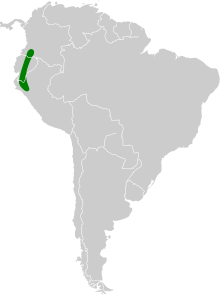Platyrrhinus ismaeli
Platyrrhinus ismaeli is a species of bat found in South America.
| Platyrrhinus ismaeli | |
|---|---|
| Scientific classification | |
| Kingdom: | Animalia |
| Phylum: | Chordata |
| Class: | Mammalia |
| Order: | Chiroptera |
| Family: | Phyllostomidae |
| Genus: | Platyrrhinus |
| Species: | P. ismaeli |
| Binomial name | |
| Platyrrhinus ismaeli Velazco, 2005 | |
 | |
Taxonomy and etymology
It was described as a new species in 2005 by zoologist Paul Velazco. Its description was the result of a taxonomic split in Thomas's broad-nosed bat, P. dorsalis.[1] The holotype had been collected in May 1987 near Balsas District, Peru.[2] Phylogenetically, it belongs to the "Andean" clade of its genus. Other members of this clade are P. albericoi, P. aurarius, P. chocoensis, P. dorsalis, P. infuscus, P. masu, P. nigellus, and P. vittatus. P. masu is the sister taxa of P. ismaeli, or its closest relative.[3]
The eponym of the species name is Ismael Ceballos Bendezú, a Peruvian mammalogist.[4] Velazco named the species after him "in recognition of his important contributions to the study of Peruvian bats."[2]
Description
It is a medium-sized member of its genus, with a forearm length of 50–56 mm (2.0–2.2 in) and a body mass of 30–51 g (1.1–1.8 oz). The fur on its back is dark brown, and its ventral fur is grayish. It has dark facial stripes of differing sizes. It has a stripe running down the length of its spine that is lighter than its facial stripes. Its nose-leaf is longer than it is wide. Males and females are similar in appearance.[2]
Biology
Little is known about its reproduction. A pregnant female was once documented in late January, while another female with more advanced pregnancy was documented in early March.[5] It is "basically frugivorous".[1]
Range and habitat
It has been documented on both sides of the Andes in Peru, Ecuador, and Colombia. It occurs at relatively high elevation, from 1,230–2,950 m (4,040–9,680 ft) above sea level.[2] It is often found in montane forests.[1]
Conservation
It is currently evaluated as near-threatened by the IUCN. Its most recent assessment in 2016 was a down-listing from its 2008 assessment as vulnerable. It meets the criteria for near-threatened because its habitat quality and extent is decreasing rapidly, which may negatively affect its population. While there was a suspected population decline from 2001–2015, it is suspected that it was less than 30%.[1]
External links
References
- Solari, S. (2016). "Platyrrhinus ismaeli". The IUCN Red List of Threatened Species. 2016: e.T136232A22002129. doi:10.2305/IUCN.UK.2016-2.RLTS.T136232A22002129.en.
- Velazco, P. M. (2005). "Morphological Phylogeny of the Bat Genus Platyrrhinus (Chiroptera: Phyllostomidae) with the Description of Four New Species". Fieldiana Zoology (105): 27–53.
- Velazco, P. M.; Patterson, B. D. (2008). "Phylogenetics and biogeography of the broad-nosed bats, genus Platyrrhinus (Chiroptera: Phyllostomidae)". Molecular Phylogenetics and Evolution. 49 (3): 749–759. doi:10.1016/j.ympev.2008.09.015. PMID 18926914.
- Beolens, Bo; Watkins, Michael; Grayson, Michael (2009). The Eponym Dictionary of Mammals. Baltimore: The Johns Hopkins University Press. p. 440. ISBN 978-0-8018-9304-9. OCLC 270129903.
- Eger, J. L. (2008). "Family Molossidae P. Gervais, 1856". In Gardner, A.L. (ed.). Mammals of South America. Volume 1. Marsupials, xenarthrans, shrews, and bats. Chicago: The University Chicago Press. p. 338. ISBN 978-0801884948.
